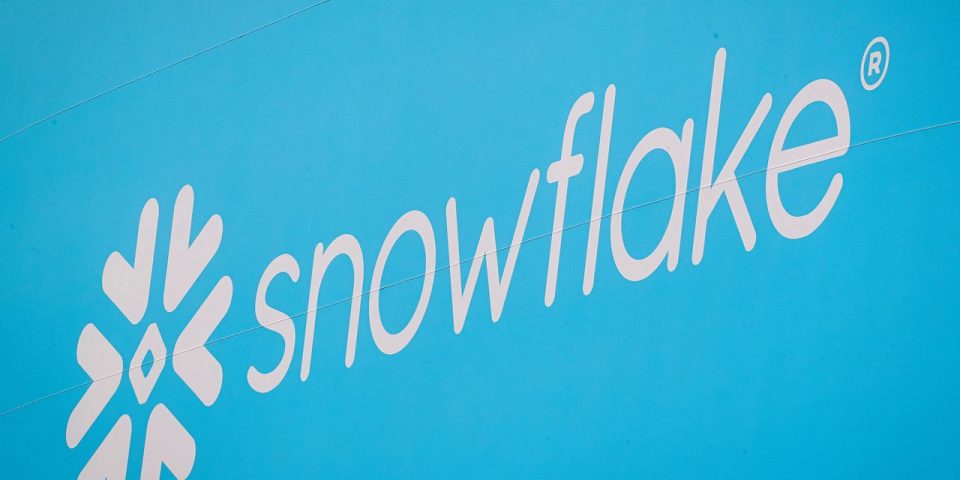Though causing jitters among investors,
Snowflake Inc.’s
strategy of only charging companies for the digital resources they use on its data-warehousing platform is proving to be a boon for corporate technology chiefs, tech industry and market analysts said.
Snowflake shares dropped sharply Wednesday after the Bozeman, Mont.-based company said it now expects sales of between $1.88 billion and $1.9 billion for its full fiscal year ending next January, below analysts’ expectations of roughly $2 billion, according to FactSet. Shares sank further Friday.
Companies use Snowflake’s software to speed up their business-data analytics abilities. The software runs in any of the large cloud providers’ systems, including
Amazon.com Inc.’s
Amazon Web Services and
Microsoft Corp.’s
Azure.
Founded in 2012, Snowflake was valued at roughly $70 billion after its September 2020 public market debut, which saw shares open at $245, more than double its listing price. Shares closed at $209.65 Friday.
The company on Wednesday said it had 5,944 customers in the fourth quarter ended Jan. 31, up from 4,139 a year earlier.
The slide in Snowflake’s share price this week comes despite the company’s rapid growth. Snowflake’s revenue more than doubled on a year-over-year basis every quarter for the past nine quarters, including a 101% increase to about $384 million in its most recent quarter, the company said Wednesday.
“At Snowflake’s size and scale, it’s extraordinarily impressive for a company to grow at such a rapid rate,” said
Derek Zanutto,
general partner at CapitalG,
Alphabet Inc.’s
independent growth fund. “But for high growth software-as-a-service companies like Snowflake, a relatively modest percentage revenue miss gets compounded over many years into future projections.”
Driving that growth is booming demand among businesses across sectors for data capabilities, said Noel Yuhanna, vice president and principal analyst at IT research firm
Forrester Research Inc.
“Data and analytics is the core of a digital business, and without a formal strategy in place, it’s difficult to convert data into actionable insights,” Mr. Yuhanna said.
At the same time, he said, chief information officers are drawn to Snowflake’s usage-based model. Unlike more common software subscriptions—where companies typically pay a fixed rate for ongoing access to cloud-based applications—usage models offer the advantage of controlling costs by tapping the applications only as needed, Mr. Yuhanna said.
“Based on our interactions with CIOs, we find most like Snowflake’s usage-based model,” Mr. Yuhanna said.
Other data-analytics software firms offering similar pricing models include Databricks Inc. and Confluent Inc.
A focus on data-driven business decisions has become de rigueur for high-performing companies, said Adam Ronthal, research vice president at
Gartner Inc.
Many are investing heavily in digital capabilities, like Snowflake’s platform, that support these efforts, including data warehouses, data lakes and machine learning, he said.
The problem for investors, analysts said, is that under its pricing model any improvements in Snowflake’s platform will ultimately enable customers to do more with less, resulting in dialed-down usage and lower revenue. The company on Wednesday said it expects efficiency gains from new AWS chips and other software upgrades to shave some $160 million off sales in the year ahead.
Still, Snowflake’s pricing model “makes forecasting to public markets tricky, and definitely trickier than the typical SaaS subscriptions-based models that public-market investors have become more familiar with,” said Eric Anderson, a partner at Scale Venture Partners.
Mr. Anderson said in the current market climate, investors are also extremely sensitive to growth rates: “Public investors want to own the startups that will keep growing to the size of
and that will not taper off,” he said, adding that most investors are looking at even subtle differences in growth rates as indicators of future trends.
“A company like Snowflake can demonstrate near-perfect execution in a large and growing market, but an air pocket here and there can really shake the stock price in the near term,” said Mr. Zanutto, of CapitalG.
But improvements to Snowflake’s platform will continue to attract CIOs and other corporate tech leaders overseeing increasingly tight IT budgets and looking to lower costs without sacrificing capabilities, he said: “In the long term, lower costs and greater efficiencies will help drive continued customer adoption.”
Write to Angus Loten at [email protected]
Copyright ©2022 Dow Jones & Company, Inc. All Rights Reserved. 87990cbe856818d5eddac44c7b1cdeb8


